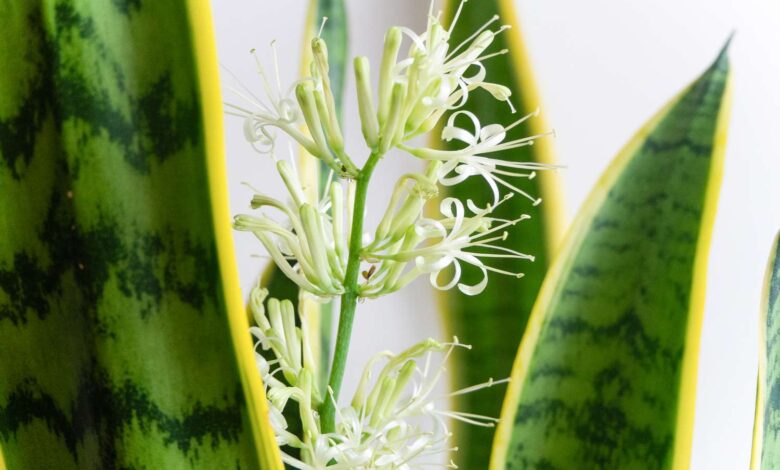Snake Plant Flower: The Secret to Making It Bloom

Introduction
snake plant flower, also known as Sansevieria or Dracaena trifasciata, is one of the most popular houseplants due to its resilience, low maintenance, and air-purifying qualities. While its iconic sword-like leaves are well-known, the snake plant has a hidden gem that many are unaware of: its rare and enchanting flower.
Snake plant flowers are a true marvel for plant enthusiasts. Their delicate appearance and fragrant scent make them a prized sight, but they bloom under specific conditions, often surprising even the most seasoned gardeners. This article will guide you through the fascinating world of snake plant flowers, from understanding their unique characteristics to encouraging their growth and appreciating their significance.
1. Understanding the Snake Plant Flower
1.1 What is the Snake Plant Flower?
Snake plant flowers are slender, tube-shaped blooms that grow on tall stalks extending from the plant’s base. Typically white or pale green, these flowers exude a subtle, sweet fragrance that becomes more prominent at night. When blooming, they can produce small droplets of nectar, adding to their mystique.
Unlike their robust leaves, snake plant flowers have a delicate and ephemeral quality. Blooming is sporadic and often surprises plant owners who were unaware their snake plant could flower.
1.2 Why is it Rare?
The rarity of snake plant flowers stems from the plant’s natural survival strategy. In their native environment, snake plants focus on leaf growth to store water and withstand harsh conditions. Flowering requires specific environmental triggers, such as optimal light, temperature, and care.
Additionally, snake plants only bloom when they reach maturity, which can take several years. This infrequent blooming makes the sight of a snake plant flower even more special.
2. Conditions for Snake Plant Flowering
2.1 Ideal Environment for Blooming
Snake plants thrive in bright, indirect sunlight, though they are highly adaptable to low-light conditions. To encourage flowering, place your plant in a well-lit area, such as near a window with filtered sunlight.
Temperature also plays a significant role. Snake plants prefer a range of 60–80°F (15–27°C) and may struggle to flower in extreme cold or heat. Consistent temperatures create a stable environment for growth and bloom.
2.2 Proper Watering and Soil Choices
Overwatering is the most common mistake plant owners make with snake plants. These succulents prefer to dry out completely between waterings. Ensure the soil is well-draining to prevent root rot, which can inhibit flowering.
A cactus or succulent potting mix is ideal for snake plants. Adding perlite or sand to the soil improves drainage and mimics the plant’s native habitat.
2.3 Fertilizers and Nutritional Needs
Fertilizing can provide the extra nutrients needed to stimulate blooming. Use a balanced houseplant fertilizer diluted to half strength during the growing season (spring and summer). Avoid over-fertilizing, as this can damage the plant and hinder blooms.
3. How to Encourage Your Snake Plant to Bloom
3.1 Patience and Plant Age
Snake plants need time to mature before they can flower. On average, it takes 3–5 years for a plant to reach maturity, depending on its care and environment. Signs of maturity include robust, well-developed leaves and steady growth.
3.2 Stressing the Plant for Results
Interestingly, mild stress can sometimes encourage a snake plant to bloom. For instance, letting the plant sit in a slightly root-bound pot or watering less frequently can mimic the natural conditions that trigger flowering. However, this must be done cautiously to avoid harming the plant.
3.3 Seasonal Tips for Success
The best chance for flowering often occurs during the warmer months when the plant is most active. Adjust watering and fertilizing routines accordingly, and ensure your plant has adequate light and warmth. During winter, allow the plant to rest by reducing watering and avoiding fertilizer.
4. The Significance of the Snake Plant Flower
4.1 Cultural and Symbolic Meanings
Throughout history, the snake plant has been associated with protection and good fortune. In some cultures, a blooming snake plant is seen as a symbol of prosperity and positive energy. Its upright growth and resilience make it a popular choice for Feng Shui, where it is believed to bring harmony and purify the surrounding space.
4.2 Benefits of the Bloom
Beyond its aesthetic appeal, the snake plant flower offers sensory delights. Its sweet fragrance can create a calming atmosphere, particularly in the evening when the scent intensifies. The flower’s rarity also adds a sense of achievement and joy for plant owners.
4.3 Common Issues and How to Address Them
Despite your best efforts, your snake plant may encounter challenges that prevent flowering. Common issues include overwatering, insufficient light, or pest infestations. Regularly inspect your plant for signs of stress, such as yellowing leaves or stunted growth, and address these issues promptly.
Conclusion
The snake plant flower is a rare and captivating phenomenon that adds a touch of magic to an already beloved houseplant. By understanding the plant’s needs and creating the right conditions, you can increase your chances of witnessing this unique bloom. Whether you’re a seasoned gardener or a casual plant enthusiast, the sight of a snake plant flower is sure to be a rewarding experience.





